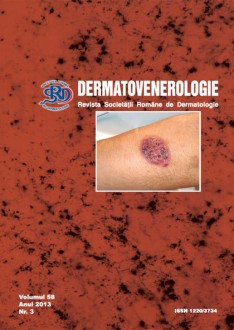Plaque-type morphea is a localized sclerodermal manifestation that is clinical characterized by hyperpigmented, thickened plaques with a clear delimitation and torso distribution. It evolves from skin erythema to skin induration and finally atrophy. It has a multitude of causes and the one in question here is Borrelia burgdorferi infection.
We will present you a 58 years old male patient clinical case, urban setting, who seeks medical advice for a hyperpigmented, thickened skin plaques. There have clear limits and are found on torso, abdominal and bilateral
forefoot. First skin manifestation was 8 months ago.
Hystopathological diagnose is plaque type morphea. ELISA and Western Blot confirm the Borrelia burgdorferi infection. After local treatment and systemic antibiotics therapy the patient condition improves.
It is imperative to know all cutaneous sign associated with Borrelia burgdorferi infection, from the more frequently and specific ones to the more rare ones to correctly identify and treat the infection.


